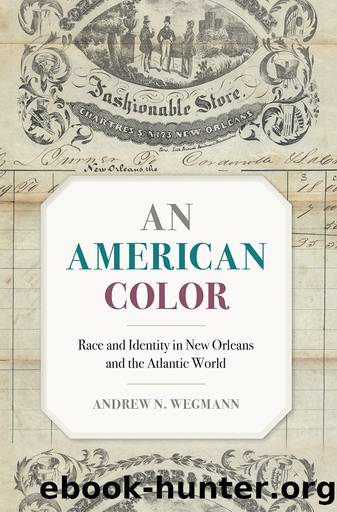An American Color by Wegmann Andrew N.;

Author:Wegmann, Andrew N.;
Language: eng
Format: epub
Publisher: University of Georgia Press
Published: 2021-04-15T00:00:00+00:00
NOTES
INTRODUCTION
1. Jean Blandin to Henry Vasserot, Natchez, Miss., May 29, 1861, LâInstitution Catholique Copy-Book, Archives of the Archdiocese of New Orleans, New Orleans, La. Also cited, in slightly different form, in Mitchell, Raising Freedomâs Child, 42â43.
2. On this insularity, see OâBrien, Conjectures of Order, 1:285â87; Thompson, Exiles at Home, 138â44; Charles E. OâNeill, âForeword,â in Desdunes, Our People and Our History, ixâxix.
3. See Olwell, Masters, Slaves, and Subjects, 44â47; Burton, Afro-Creole, 22â30; and Kenneth Morgan, Slavery and the British Empire, 84â90.
4. See DomÃnguez, White by Definition, chap. 1; Burnard, Creole Gentlemen, chap. 7; and Nicole King, C. L. R. James and Creolization, 10â21.
5. See Cole, Krio of West Africa, chaps. 1, 3, and 4; Fanon, Wretched of the Earth, 138â42; Wyse, Krio of Sierra Leone, 23â36; Usner, ââFacility Offered by the Country,ââ 38â45; and Wegmann, ââUpon This Rock,ââ 63â68.
6. The historiography of Enlightenment racial science is vast, but very few studies either look at the New World as a testing ground for scientific theories or consider the place of people of mixed race in the creation and development of those theories. For the best, most objective, historical treatment of American adaptations of Enlightenment racial science, see Stanton, Leopardâs Spots. Other, more subjective treatments include Stephens, Science, Race, and Religion; Dain, Hideous Monster of the Mind; Horsman, Race and Manifest Destony; Fabian, Skull Collectors; Irmscher, Louis Agassiz; and Dugatkin, Mr. Jefferson. The best study of the racial theories of the Enlightenment, especially as they related to slavery and the Atlantic world, is Curran, Anatomy of Blackness.
7. The books that cite Berlinâs Slaves without Masters, or use it with abandon, are far too numerous to list. The most notable are Koger, Black Slaveowners; Curry, Free Black in Urban America; Horton and Horton, In Hope of Liberty; Schweninger, Black Property Owners; Johnson and Roark, Black Masters; Myers, Forging Freedom; Bristol, Knights of the Razor; Ford, Deliver Us from Evil, chaps. 1 and 3; and Gudmestad, Troublesome Commerce.
8. See Berlin, Slaves without Masters, chap. 4.
9. For New Orleans as an isolated, unique, largely âun-Americanâ city and culture, see ibid.; Myers, Forging Freedom, especially introduction and chap. 2; Schweninger, Black Property Owners, chap. 4; Hirsch and Logsdon, Creole New Orleans; Toledano et al., New Orleans Architecture, vol. 4; Kein, Creole; Powell, Accidental City; Bell, Revolution, Romanticism; Brasseaux, Fontenot, and Oubre, Creoles of Color; Dormon, Creoles of Color; and Everett, âFree Persons of Color.â
10. For excellent, but purely regional studies of race in New Orleans, Louisiana, and the Gulf Coast, see Hanger, Bounded Lives, Bounded Places; Ingersoll, Mammon and Manon; Gary B. Mills, Forgotten People; and Usner, Indians, Settlers, and Slaves. For the few studies that expand the standard area of investigation, see, most notably, Spear, Race, Sex, and Social Order; Emily Clark, Strange History; Gwendolyn Midlo Hall, Africans in Colonial Louisiana; and Vidal, Louisiana.
11. Most notable among recent studies focused in large part on the territorial period in Louisiana and New Orleans is Eberhard L. Faber, Building the Land of Dreams. For an analysis of
Download
This site does not store any files on its server. We only index and link to content provided by other sites. Please contact the content providers to delete copyright contents if any and email us, we'll remove relevant links or contents immediately.
| Americas | African Americans |
| Civil War | Colonial Period |
| Immigrants | Revolution & Founding |
| State & Local |
In Cold Blood by Truman Capote(3311)
The Innovators: How a Group of Hackers, Geniuses, and Geeks Created the Digital Revolution by Walter Isaacson(2849)
Steve Jobs by Walter Isaacson(2837)
All the President's Men by Carl Bernstein & Bob Woodward(2331)
Lonely Planet New York City by Lonely Planet(2173)
And the Band Played On by Randy Shilts(2131)
The Room Where It Happened by John Bolton;(2105)
The Poisoner's Handbook by Deborah Blum(2094)
The Murder of Marilyn Monroe by Jay Margolis(2059)
The Innovators by Walter Isaacson(2057)
Lincoln by David Herbert Donald(1949)
A Colony in a Nation by Chris Hayes(1881)
Under the Banner of Heaven: A Story of Violent Faith by Jon Krakauer(1750)
Amelia Earhart by Doris L. Rich(1650)
The Unsettlers by Mark Sundeen(1647)
Being George Washington by Beck Glenn(1628)
Birdmen by Lawrence Goldstone(1621)
Dirt by Bill Buford(1613)
Zeitoun by Dave Eggers(1594)
